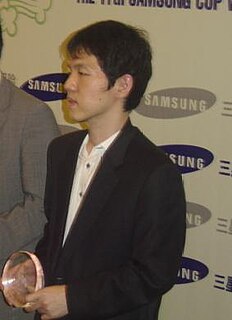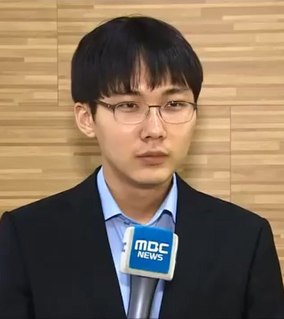
Lee Chang-ho is a South Korean professional Go player of 9-dan rank. He is regarded by many as the best Go player of the late 1990s and early 2000s. He was a student of Cho Hun-hyun 9-dan. He is the second youngest to become a professional Go player in South Korean history behind Cho Hun-hyun. He is the only player to have won all eight international competitions at least once.

Cho Hunhyun is a South Korean 9-dan professional Go player. Considered one of the greatest players of all time, Cho reached professional level in Korea in 1962. Since then, Cho has amassed 150 professional titles, more than any player in the world. He thrice held all of the open tournaments in Korea in 1980, 1982 and 1986. Cho has also won 11 international titles, third most in the world behind Lee Chang-ho (21) and Lee Sedol (18). He reached 1,000 career wins in 1995.
Rui Naiwei is a Chinese professional Go player, once active in South Korea. She is probably the strongest recorded female Go player, and is the only woman to have won one of the major open Go titles. She achieved this by winning the 1999 Guksu title, on the way beating Lee Chang-Ho and Cho Hun-hyun, the two strongest players in the World at the time.

Cho Chikun25th HoninboHonorary Meijin is a professional South Korean Go player and a nephew of Cho Namchul. His total title tally of 75 titles is the most in the history of the Japanese Nihon Ki-in. Cho is the first player to hold the top three titles—Kisei, Meijin, and Honinbo—simultaneously which he did for three years in a row. Cho is the first in history to win all of the "Top 7" titles in Japan which he achieved by winning the Oza in 1994. Cho U in 2011 and Iyama Yuta in 2013 would duplicate this feat, both by winning the Kisei. He is also one of the 'Six Supers' Japanese players that were most celebrated in the late twentieth century, along with Rin Kaiho, Otake Hideo, Takemiya Masaki, Kato Masao and his classmate and arch-rival Kobayashi Koichi. He is the author of several books on Go.
Cho U is a Taiwanese professional Go player. He currently ranks 6th in the most titles won by a Japanese professional; his NEC Cup win in 2011 put him past his teacher Rin Kaiho and Norimoto Yoda. Cho is the first player in history to have held five of the top seven major titles simultaneously with Iyama Yuta being the second. Cho U, Naoki Hane, Keigo Yamashita and Shinji Takao make up the group of players in Japan called the "Four Heavenly Kings". His wife is one of Japan's best female go professionals, Izumi Kobayashi, the great Kitani's granddaughter and daughter of Kobayashi Koichi.

Yuta Iyama Kisei, Honinbo, Meijin is a Japanese professional Go player. In April 2016, he became the first player in Japanese history to hold all seven major titles simultaneously. In January 2018, Iyama became the first professional Go player to be awarded Japan's People's Honour Award.
Hideyuki Fujisawa, also known as Shuko Fujisawa, was a Japanese professional Go player. A younger uncle of another professional, Hosai Fujisawa and grandfather of professional Go player Hideyuki Fujisawa.
Satoshi Yuki is a Japanese professional Go player.
The Ing Cup is an international Go tournament with a cash prize of over US$400,000. It was created by, and is named after, Ing Chang-ki. The tournament is held once every four years and hence often nicknamed the Go Olympics.
Kimio Yamada is a professional Go player. A territorial player who is adept at invading and living within opponent's spheres of influence, Yamada won his first major title, the Oza, in 1997. He has two older brothers, Shiho Yamada and Wakio Yamada.
The 1st Kisei was the birth of a new Go tournament. Since this was the first year of the tournament, there was no set challenger or holder. From the 2nd edition on, there has been a playoff between challengers. At the time, it was the highest paying tournament there had ever been, and would be until the creation of the Ing Cup. Fujisawa Hideyuki's win would mark the beginning of a six-year defense of the Kisei title from 1977 to 1982.

Park Junghwan is a South Korean professional Go player of 9-dan rank.
The 18th Agon Cup began on 21 April 2011 – 1 October 2011. Two Korean amateur players were invited to the preliminaries, with both qualifying. Ha Sungbong defeated professionals Yanigasawa Satoshi and Furuya Yutaka. Kim Sungjin defeated 25th Honinbo and Japan's top title holder Cho Chikun. He also defeated Kato Atsushi. In the main tournament, he was knocked out by Iyama Yuta Meijin in the first round. Iyama Yuta came out as the winner. He beat Yamashita Keigo at the final. The winner's prize was ¥10,000,000.
Hsieh Yimin is a Taiwanese-born professional Go player in Japan. She holds the titles of Honorary Female Honinbo and Honorary Female Meijin, and currently holds three major female titles in Japan: Female Meijin, Female Kisei and Female Honinbo.
The Women's Hollyhock Cup, formerly known as Aizu Central Hospital Cup before 2017, is a Go competition for female Go players. The tournament was introduced in 2014.

Rina Fujisawa is a Japanese professional Go player.
Ryo Ichiriki is a Japanese professional 9-dan Go player and journalist. As Go player, he was a pupil of So Kofuku. Since 2020 he also have worked as journalist at Kahoku Shimpo.
The Bingsheng Cup is an international women's Go tournament. It was created in 2010 and is held annually. The tournament is held at Qionglong Mountain in Suzhou, Jiangsu, China. It is also known as the Qionglong Mountain Bingsheng Cup. The name bingsheng is in honor of Sun Tzu, who is said to have written The Art of War at Qionglong Mountain; the historicity of Sun Tzu is uncertain.





